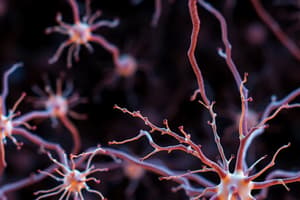Podcast
Questions and Answers
Which structure is primarily responsible for connecting the two halves of the cerebrum?
Which structure is primarily responsible for connecting the two halves of the cerebrum?
- Thalamus
- Corpus callosum (correct)
- Cerebellum
- Hippocampus
Which part of the brain is specifically involved in the regulation of body temperature, eating, and drinking?
Which part of the brain is specifically involved in the regulation of body temperature, eating, and drinking?
- Hypothalamus (correct)
- Cerebrum
- Pons
- Medulla
Which part of the nervous system processes sensory information received from the sensory organs?
Which part of the nervous system processes sensory information received from the sensory organs?
- Somatic nervous system
- Central nervous system (correct)
- Spinal cord
- Peripheral nervous system
What is the primary function of the limbic system?
What is the primary function of the limbic system?
What do the pons primarily consist of?
What do the pons primarily consist of?
Which of the following structures is involved in auditory processing within the midbrain?
Which of the following structures is involved in auditory processing within the midbrain?
Which part of the hindbrain is crucial for maintaining balance and coordinating voluntary movements?
Which part of the hindbrain is crucial for maintaining balance and coordinating voluntary movements?
What does the process of reflex action involve?
What does the process of reflex action involve?
Which component of the central nervous system is responsible for the processing and integration of visual, tactile, and auditory inputs?
Which component of the central nervous system is responsible for the processing and integration of visual, tactile, and auditory inputs?
Which neurotransmitters are primarily involved in the transmission of impulses at chemical synapses?
Which neurotransmitters are primarily involved in the transmission of impulses at chemical synapses?
Flashcards are hidden until you start studying
Study Notes
Human Neural System Overview
- Composed of specialized cells called neurons for detecting, receiving, and transmitting stimuli.
- Simplest neural organization in lower invertebrates, like Hydra, which has a network of neurons.
- Insects possess a more advanced structure with a brain, ganglia, and neural tissues.
- Vertebrates, including humans, have a highly developed neural system.
Structure of the Human Neural System
- Divided into two main parts:
- Central Nervous System (CNS): Includes the brain and spinal cord; processes and controls information.
- Peripheral Nervous System (PNS): Comprises all nerves linked to the CNS.
- PNS consists of two types of nerve fibres:
- Afferent fibres: Transmit impulses from organs to CNS.
- Efferent fibres: Carry regulatory impulses from CNS to peripheral tissues.
- Further divided into:
- Somatic Nervous System: Relays impulses to skeletal muscles.
- Autonomic Nervous System: Relays impulses to involuntary organs and smooth muscles.
Neuron Structure and Function
- Neurons are excitable cells with polarized membranes.
- At rest, axonal membranes are more permeable to potassium ions (K+) than to sodium ions (Na+).
- Sodium-potassium pump maintains ionic concentration gradients, critical for impulse generation.
- Action potential is the electrical potential difference across the membrane when depolarization occurs.
- Impulse conduction involves sequential depolarization along the axon, creating a wave of action potentials.
Impulse Transmission
- Occurs at synapses, the junctions between neurons.
- Signals are transmitted chemically using neurotransmitters.
- Each presynaptic neuron connects with a postsynaptic neuron, often separated by a synaptic cleft.
Sensory Reception and Processing
- Sensory organs detect changes in the environment and send signals to the CNS for processing.
- The nose detects smell through olfactory receptors located in the olfactory epithelium, sending signals to the olfactory bulb in the limbic system.
- The tongue perceives taste via taste buds, integrating signals for complex flavor interpretations.
Eye and Ear Structures
- Human eyes are located in orbits and serve as sensory organs for vision.
- Information regarding environmental changes is relayed through sensory organs to the CNS for further processing.
Brain Structure and Function
- The brain is divided into three major parts:
- Forebrain: Includes the cerebrum (longitudinally divided, connected by corpus callosum), thalamus, and hypothalamus, which regulates body temperature, thirst, and hunger.
- Midbrain: Integrates visual, tactile, and auditory inputs.
- Hindbrain: Comprises pons, cerebellum, and medulla; regulates respiration, cardiovascular reflexes, and muscle coordination.
Reflex Action
- Reflex actions are involuntary responses to stimuli, processed by the CNS after sensory input.
- Crucial for rapid responses to environmental changes, reinforcing the importance of the neural system in coordinating bodily functions.
Studying That Suits You
Use AI to generate personalized quizzes and flashcards to suit your learning preferences.




